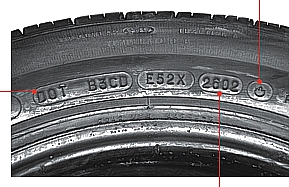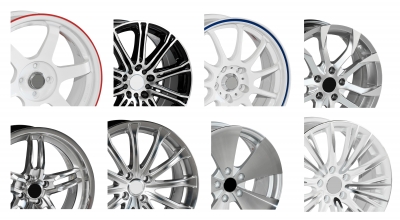
Tired of me writing about tires? Allow me one more post for the year...well, for now.


First thing's first—some clarification:


Note: When you say wheel in our trade, it doesn't mean tire!
As with all things cars, maintenance is key—that includes properly storing your extra set of tires, be it winter or spring season. Remember that your tires are made of rubber and will age naturally over time. Storing them properly will help prevent premature tire wear.
If you leave tires for a long period of time in any given position, they'll develop a flat spot—this applies whether the tires are stored upright or on their side—however, you'll notice it less when the tires are on their side, because they have better weight distribution. If you have rims with tires, store them with the rim-side up to prevent damaging the rim. For the super organized, you could get a tire stand.
If you have an extra set of tires and rims, another option is to hang them up on your garage wall. Just make sure that the weight is being held by the rim, to avoid pressure on the rubber tires.
Usually we give clients tires back in bags (plastic or fabric totes). It's important to open up these bags when you get home and let the tires and/or rims dry out. Trapped moisture may cause rust, particularly if your tires are mounted on rims.
Since tires are made of rubber, avoid storing them where there's major fluctuations in temperature. Heat is also detrimental to the rubber, causing it to dry out and crack. Tires get good traction on the road if they stay malleable—dried out tires are dangerous, because they're unable to flex with the road conditions and will cause a sudden blow out.
If you're planning to throw out tires that are mounted on rims and purchase new tires next season, it's a good idea to keep the old tires anyway, to prevent damage to the rim during moving and storage.
Thinking of getting winter tires for your car? What should you look out for? Click here to find out!
Image via freedigitalphotos.net

Shopping around for winter tires? Tires in general are a subjective purchase and there are so many options to choose from, like buying 'white' wedding invitations—pearl white, cloud white, bright white, super-clean-teeth white. You get the idea.
Here are some tips from Transport Canada to keep in mind when buying winter tires:


Installing only two winter tires is dangerous. It doesn't matter if your car is front wheel drive, rear wheel drive, or all-wheel drive. Winter tires installed only in the front of the vehicle will cause fishtailing, where the rear end of the car has no traction and you will have absolutely no control. Winter tires installed only in the rear of the car affects your ability to steer, because the feedback you get from the tires will cause you to either oversteer (to turn more sharply than needed) or understeer (you guessed it, to turn less sharply than expected).
While the minimum thickness of all season tire treads is 2/32”, we recommend replacing winter tires when the treads are 4/32”. Less than that, there's really not much tread left on the tire for it to cut through the snow and maintain traction on the road.
Click here to learn more about winter tires.